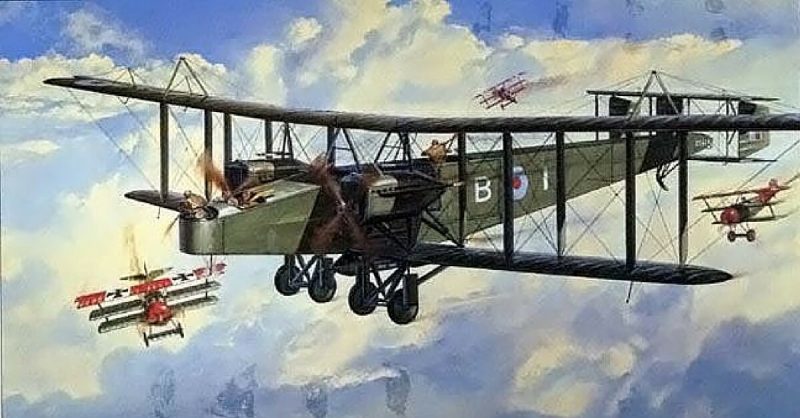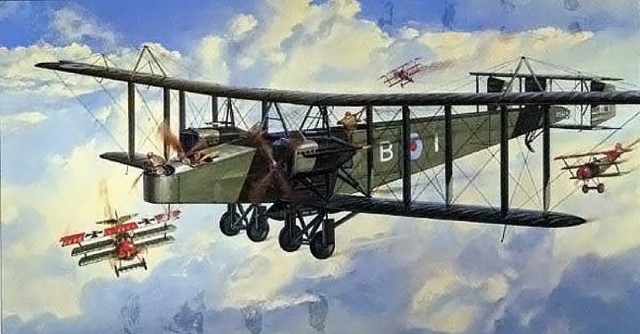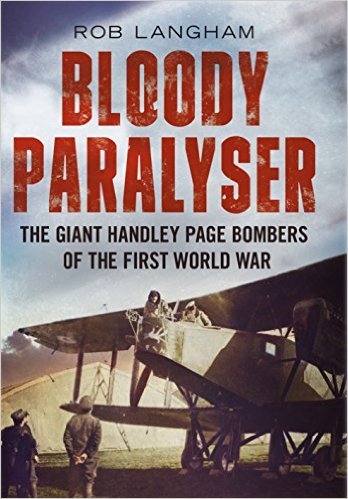I had the pleasure of reviewing Rob Langham’s first book some time back and now he has returned with a second. I am not kidding when I say it is really rather excellent. This time round Rob forsakes railways for the story of the huge Handley-Page bombers of the Great War that struck fear and bewilderment wherever they went. These bombers were the ancestors of the famous heavies the RAF used during World War II and some of the men involved with them were still around to direct the offensive against Germany a generation later.
Along with the Gotha these aircraft are the epitome of pioneering heavy bombers and although their payload was tiny in comparison to what was to follow the O/100 and O/400 were successful machines. The later V/1500 was even larger and more complicated. Plans to use them on raids to Berlin were cut short by the Armistice.
Rob points out that while we will never know how successful they actually were as distinct from the other types engaged by the RFC, RNAS and RAF in bombing missions; we do know the Handley Page was capable of causing serious damage and inflicting terror wherever it went. The big Handley Page was Britain’s way of hitting back, but much, more importantly, they could do serious damage to life and property. Given the terrors of first airships and then the England Geschwader’s Gothas it is safe to assume there was universal satisfaction in the UK when news of attacks on German town and cities was announced in the press.
Bombing was literally a hit or miss affair and despite the jokes the Handley Page crews had to rely on not much more than their wits. It is important to remember that when the RAF took time to survey their bombing effort during World War II the crews of Bomber Command were facing the same hurdles as the men who flew the Bloody Paralyser. For the men of 1918 there were contingencies available to make the best use of bomber crews and precious aircraft and it was not unusual to see large parts of crashed aircraft used to make new ones. The crews were presented with the novelty of flying something a great deal bigger than anything else in service and, despite the inevitable accidents, the majority found these big birds pleasing to fly.
Rob explores the efforts to find additional roles for these big aircraft and we learn of mixed fortunes in that respect, but as a bomber the Handley Page was really up to the job. Like so many aircraft of the time the aircraft was limited by the power and reliability of its engines during a period when Rolls-Royce were finding their feet with aero-engine designs and manufacturing. Other companies had their own products but the Rolls faired better than all of them. The big problem being they just couldn’t build enough of them.
Mr Langham makes good use of primary sources in the form of official and personal documents and colourful descriptions extracted from the Imperial War Museum’s wonderful sound archive. Flying one of these leviathans was no easy business and the skill and what they used to call pluck of the airmen has to be admired. Like the planes they flew these men were giants.
My previous contact with these monsters amounts to a disastrous attempt to build the Airfix 1/72nd scale kit of the O/400 when I was a lad. Suffice to say it was never finished. Sadly none survive so you will have to make do with photographs. Rob has picked a number of gems to give a flavour of the aircraft and this includes the first prototype that had an enclosed cockpit. It was unpopular at the time, but improvements in aircraft design during the inter-war years would see something we take for granted finding favour with pilots and operators.
The Handley Page was just a bit too big for some people and it faced rivals in the shape of the successful Vickers Vimy and one-offs such as the stupendous Tarrant Tabor. Finding a role for the aircraft in the immediate post-war period was not as straightforward as one might think. Converting them into airliners did not prove to be a roaring success despite a lot of effort. The sad fact is they were just too big for their time and even the RAF wasn’t sorry to see the back of them. The rush to disarm at the end of the war signalled the death of the Handley Page.
The Vickers Vimy and Virginia and even Handley Page’s Hyderabad filled the some of the void between the wars. But it took the urgent need to rearm to see the heavy bomber become a part of British strategy. The rest, as they say, is history.
Handley Page built their reputation on large aircraft and while the Halifax of World War II fame is an obvious example my favourite of all the company’s bombers is the awkward but pleasing looking Heyford. I would love to have seen one of those.
Rob Langham has done a first-rate job here. He combines all the essential ingredients to make for an informative and entertaining history and I strongly believe he will be a very successful writer in good time. Fonthill have a track record for producing high-quality Great War aviation histories and this one sits perfectly with recent releases. I often find books like this one are a little topsy-turvy when balancing detailed facts with colourful characters. Fortunately the author keeps us engaged from first to last.
There is no doubt in my mind we will be seeing much more of Rob Langham. He has developed a keen and yet pleasing style and I very much look forward to seeing what he does next.
Reviewed by Mark Barnes for War History Online.
BLOODY PARALYSER
The Giant Handley Page Bombers of the First World War
By Rob Langham
Fonthill Media
ISBN: 978 1 78155 080 9
*** Mark will be interviewing Rob Langham for us in the next few days.


